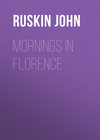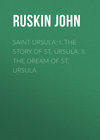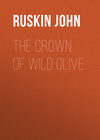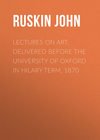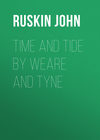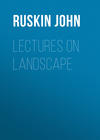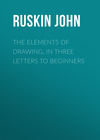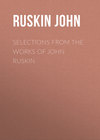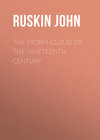Buch lesen: «Mornings in Florence», Seite 7
We are now to read the series of the Divine sciences, beginning at the opposite side, next the window.
VIII. CIVIL LAW. Civil, or 'of citizens,' not only as distinguished from Ecclesiastical, but from Local law. She is the universal Justice of the peaceful relations of men throughout the world, therefore holds the globe, with its three quarters, white, as being justly governed, in her left hand.
She is also the law of eternal equity, not erring statute; therefore holds her sword level across her breast. She is the foundation of all other divine science. To know anything whatever about God, you must begin by being Just.
Dressed in red, which in these frescoes is always a sign of power, or zeal; but her face very calm, gentle and beautiful. Her hair bound close, and crowned by the royal circlet of gold, with pure thirteenth century strawberry leaf ornament.
Under her, the Emperor Justinian, in blue, with conical mitre of white and gold; the face in profile, very beautiful. The imperial staff in his right hand, the Institutes in his left.
Medallion, a figure, apparently in distress, appealing for justice. (Trajan's suppliant widow?)
Technical Points.—The three divisions of the globe in her hand were originally inscribed ASIA, AFRICA, EUROPE. The restorer has ingeniously changed AF into AME—RICA. Faces, both of the science and emperor, little retouched, nor any of the rest altered.
IX. CHRISTIAN LAW. After the justice which rules men, comes that which rules the Church of Christ. The distinction is not between secular law, and ecclesiastical authority, but between the equity of humanity, and the law of Christian discipline.
In full, straight-falling, golden robe, with white mantle over it; a church in her left hand; her right raised, with the forefinger lifted; (indicating heavenly source of all Christian law? or warning?)
Head-dress, a white veil floating into folds in the air. You will find nothing in these frescoes without significance; and as the escaping hair of Geometry indicates the infinite conditions of lines of the higher orders, so the floating veil here indicates that the higher relations of Christian justice are indefinable. So her golden mantle indicates that it is a glorious and excellent justice beyond that which unchristian men conceive; while the severely falling lines of the folds, which form a kind of gabled niche for the head of the Pope beneath, correspond with the strictness of true Church discipline firmer as well as more luminous statute.
Beneath, Pope Clement V., in red, lifting his hand, not in the position of benediction, but, I suppose, of injunction,—only the forefinger straight, the second a little bent, the two last quite. Note the strict level of the book; and the vertical directness of the key.
The medallion puzzles me. It looks like a figure counting money.
Technical Points.—Fairly well preserved; but the face of the science retouched: the grotesquely false perspective of the Pope's tiara, one of the most curiously naïve examples of the entirely ignorant feeling after merely scientific truth of form which still characterized Italian art.
Type of church interesting in its extreme simplicity; no idea of transept, campanile, or dome.
X. PRACTICAL THEOLOGY. The beginning of the knowledge of God being Human Justice, and its elements defined by Christian Law, the application of the law so defined follows, first with respect to man, then with respect to God.
"Render unto Caesar the things that are Caesar's—and to God the things that are God's."
We have therefore now two sciences, one of our duty—to men, the other to their Maker.
This is the first: duty to men. She holds a circular medallion, representing Christ preaching on the Mount, and points with her right hand to the earth.
The sermon on the Mount is perfectly expressed by the craggy pinnacle in front of Christ, and the high dark horizon. There is curious evidence throughout all these frescos of Simon Memmi's having read the Gospels with a quite clear understanding of their innermost meaning.
I have called this science Practical Theology:—the instructive knowledge, that is to say, of what God would have us do, personally, in any given human relation: and the speaking His Gospel therefore by act. "Let your light so shine before men."
She wears a green dress, like Music her hair in the Arabian arch, with jewelled diadem.
Under David. Medallion, Almsgiving. Beneath her, Peter Lombard,
Technical Points.—It is curious that while the instinct of perspective was not strong enough to enable any painter at this time to foreshorten a foot, it yet suggested to them the expression of elevation by raising the horizon.
I have not examined the retouching. The hair and diadem at least are genuine, the face is dignified and compassionate, and much on the old lines.
XI. DEVOTIONAL THEOLOGY.—Giving glory to God, or, more accurately, whatever feelings He desires us to have towards Him, whether of affection or awe.
This is the science or method of devotion for Christians universally, just as the Practical Theology is their science or method of action.
In blue and red: a narrow black rod still traceable in the left hand; I am not sure of its meaning. ("Thy rod and Thy staff, they comfort me?") The other hand open in admiration, like Astronomy's; but Devotion's is held at her breast. Her head very characteristic of Memmi, with upturned eyes, and Arab arch in hair. Under her, Dionysius the Areopagite—mending his pen! But I am doubtful of Lord Lindsay's identification of this figure, and the action is curiously common and meaningless. It may have meant that meditative theology is essentially a writer, not a preacher.
The medallion, on the other hand, is as ingenious. A mother lifting her hands in delight at her child's beginning to take notice.
Under St. Paul.
Technical Points.—Both figures very genuine, the lower one almost entirely so. The painting of the red book is quite exemplary in fresco style.
XII. DOGMATIC THEOLOGY.—After action and worship, thought becoming too wide and difficult, the need of dogma becomes felt; the assertion, that is, within limited range, of the things that are to be believed.
Since whatever pride and folly pollute Christian scholarship naturally delight in dogma, the science itself cannot but be in a kind of disgrace among sensible men: nevertheless it would be difficult to overvalue the peace and security which have been given to humble persons by forms of creed; and it is evident that either there is no such thing as theology, or some of its knowledge must be thus, if not expressible, at least reducible within certain limits of expression, so as to be protected from misinterpretation.
In red,—again the sign of power,—crowned with a black (once golden?) triple crown, emblematic of the Trinity. The left hand holding a scoop for winnowing corn; the other points upwards. "Prove all things—hold fast that which is good, or of God."
Beneath her, Boethius. Under St. Mark. Medallion, female figure, laying hands on breast.
Technical Points.—The Boethius entirely genuine, and the painting of his black book, as of the red one beside it, again worth notice, showing how pleasant and interesting the commonest things become, when well painted.
I have not examined the upper figure.
XIII. MYSTIC THEOLOGY.25 Monastic science, above dogma, and attaining to new revelation by reaching higher spiritual states.
In white robes, her left hand gloved (I don't know why)—holding chalice. She wears a nun's veil fastened under her chin, her hair fastened close, like Grammar's, showing her necessary monastic life; all states of mystic spiritual life involving retreat from much that is allowable in the material and practical world.
There is no possibility of denying this fact, infinite as the evils are which have arisen from misuse of it. They have been chiefly induced by persons who falsely pretended to lead monastic life, and led it without having natural faculty for it. But many more lamentable errors have arisen from the pride of really noble persons, who have thought it would be a more pleasing thing to God to be a sibyl or a witch, than a useful housewife. Pride is always somewhat involved even in the true effort: the scarlet head-dress in the form of a horn on the forehead in the fresco indicates this, both here, and in the Contemplative Theology.
Under St. John.
Medallion unintelligible, to me. A woman laying hands on the shoulders of two small figures.
Technical Points.—More of the minute folds of the white dress left than in any other of the repainted draperies. It is curious that minute division has always in drapery, more or less, been understood as an expression of spiritual life, from the delicate folds of Athena's peplus down to the rippled edges of modern priests' white robes; Titian's breadth of fold, on the other hand, meaning for the most part bodily power. The relation of the two modes of composition was lost by Michael Angelo, who thought to express spirit by making flesh colossal.
For the rest, the figure is not of any interest, Memmi's own mind being intellectual rather than mystic.
XIV. POLEMIC THEOLOGY.26
"Who goes forth, conquering and to conquer?" "For we war, not with flesh and blood," etc.
In red, as sign of power, but not in armour, because she is herself invulnerable. A close red cap, with cross for crest, instead of helmet. Bow in left hand; long arrow in right.
She partly means Aggressive Logic: compare the set of her shoulders and arms with Logic's.
She is placed the last of the Divine sciences, not as their culminating power, but as the last which can be rightly learned. You must know all the others, before you go out to battle. Whereas the general principle of modern Christendom is to go out to battle without knowing any one of the others; one of the reasons for this error, the prince of errors, being the vulgar notion that truth may be ascertained by debate! Truth is never learned, in any department of industry, by arguing, but by working, and observing. And when you have got good hold of one truth, for certain, two others will grow out of it, in a beautifully dicotyledonous fashion, (which, as before noticed, is the meaning of the branch in Logic's right hand). Then, when you have got so much true knowledge as is worth fighting for, you are bound to fight for it. But not to debate about it, any more.
There is, however, one further reason for Polemic Theology being put beside Mystic. It is only in some approach to mystic science that any man becomes aware of what St. Paul means by "spiritual wickedness in heavenly27 places;" or, in any true sense, knows the enemies of God and of man.
Beneath St. Augustine. Showing you the proper method of controversy;—perfectly firm; perfectly gentle.
You are to distinguish, of course, controversy from rebuke. The assertion of truth is to be always gentle: the chastisement of wilful falsehood may be—very much the contrary indeed. Christ's sermon on the Mount is full of polemic theology, yet perfectly gentle:—"Ye have heard that it hath been said—but I say unto you";—"And if ye salute your brethren only, what do ye more than others?" and the like. But His "Ye fools and blind, for whether is greater," is not merely the exposure of error, but rebuke of the avarice which made that error possible.
Under the throne of St. Thomas; and next to Arithmetic, of the terrestrial sciences.
Medallion, a soldier, but not interesting.
Technical Points.—Very genuine and beautiful throughout. Note the use of St. Augustine's red bands, to connect him with the full red of the upper figures; and compare the niche formed by the dress of Canon Law, above the Pope, for different artistic methods of attaining the same object,—unity of composition.
But lunch time is near, my friends, and you have that shopping to do, you know.
THE SIXTH MORNING
THE SHEPHERD'S TOWER
I am obliged to interrupt my account of the Spanish chapel by the following notes on the sculptures of Giotto's Campanile: first because I find that inaccurate accounts of those sculptures are in course of publication; and chiefly because I cannot finish my work in the Spanish chapel until one of my good Oxford helpers, Mr. Caird, has completed some investigations he has undertaken for me upon the history connected with it. I had written my own analysis of the fourth side, believing that in every scene of it the figure of St. Dominic was repeated. Mr. Caird first suggested, and has shown me already good grounds for his belief,28 that the preaching monks represented are in each scene intended for a different person. I am informed also of several careless mistakes which have got into my description of the fresco of the Sciences; and finally, another of my young helpers, Mr. Charles F. Murray,—one, however, whose help is given much in the form of antagonism,—informs me of various critical discoveries lately made, both by himself, and by industrious Germans, of points respecting the authenticity of this and that, which will require notice from me: more especially he tells me of certification that the picture in the Uffizii, of which I accepted the ordinary attribution to Giotto, is by Lorenzo Monaco,—which indeed may well be, without in the least diminishing the use to you of what I have written of its predella, and without in the least, if you think rightly of the matter, diminishing your confidence in what I tell you of Giotto generally. There is one kind of knowledge of pictures which is the artist's, and another which is the antiquary's and the picture-dealer's; the latter especially acute, and founded on very secure and wide knowledge of canvas, pigment, and tricks of touch, without, necessarily, involving any knowledge whatever of the qualities of art itself. There are few practised dealers in the great cities of Europe whose opinion would not be more trustworthy than mine, (if you could get it, mind you,) on points of actual authenticity. But they could only tell you whether the picture was by such and such a master, and not at all what either the master or his work were good for. Thus, I have, before now, taken drawings by Varley and by Cousins for early studies by Turner, and have been convinced by the dealers that they knew better than I, as far as regarded the authenticity of those drawings; but the dealers don't know Turner, or the worth of him, so well as I, for all that. So also, you may find me again and again mistaken among the much more confused work of the early Giottesque schools, as to the authenticity of this work or the other; but you will find (and I say it with far more sorrow than pride) that I am simply the only person who can at present tell you the real worth of any; you will find that whenever I tell you to look at a picture, it is worth your pains; and whenever I tell you the character of a painter, that it is his character, discerned by me faithfully in spite of all confusion of work falsely attributed to him in which similar character may exist. Thus, when I mistook Cousins for Turner, I was looking at a piece of subtlety in the sky of which the dealer had no consciousness whatever, which was essentially Turneresque, but which another man might sometimes equal; whereas the dealer might be only looking at the quality of Whatman's paper, which Cousins used, and Turner did not.
Not, in the meanwhile, to leave you quite guideless as to the main subject of the fourth fresco in the Spanish chapel,—the Pilgrim's Progress of Florence,—here is a brief map of it:
On the right, in lowest angle, St. Dominic preaches to the group of Infidels; in the next group towards the left, he (or some one very like him) preaches to the Heretics: the Heretics proving obstinate, he sets his dogs at them, as at the fatallest of wolves, who being driven away, the rescued lambs are gathered at the feet of the Pope. I have copied the head of the very pious, but slightly weak-minded, little lamb in the centre, to compare with my rough Cumberland ones, who have had no such grave experiences. The whole group, with the Pope above, (the niche of the Duomo joining with and enriching the decorative power of his mitre,) is a quite delicious piece of design.
The Church being thus pacified, is seen in worldly honour under the powers of the Spiritual and Temporal Rulers. The Pope, with Cardinal and Bishop descending in order on his right; the Emperor, with King and Baron descending in order on his left; the ecclesiastical body of the whole Church on the right side, and the laity,—chiefly its poets and artists, on the left.
Then, the redeemed Church nevertheless giving itself up to the vanities and temptations of the world, its forgetful saints are seen feasting, with their children dancing before them, (the Seven Mortal Sins, say some commentators). But the wise-hearted of them confess their sins to another ghost of St. Dominic; and confessed, becoming as little children, enter hand in hand the gate of the Eternal Paradise, crowned with flowers by the waiting angels, and admitted by St. Peter among the serenely joyful crowd of all the saints, above whom the white Madonna stands reverently before the throne. There is, so far as I know, throughout all the schools of Christian art, no other so perfect statement of the noble policy and religion of men.
I had intended to give the best account of it in my power; but, when at Florence, lost all time for writing that I might copy the group of the Pope and Emperor for the schools of Oxford; and the work since done by Mr. Caird has informed me of so much, and given me, in some of its suggestions, so much to think of, that I believe it will be best and most just to print at once his account of the fresco as a supplement to these essays of mine, merely indicating any points on which I have objections to raise, and so leave matters till Fors lets me see Florence once more.
Perhaps she may, in kindness forbid my ever seeing it more, the wreck of it being now too ghastly and heartbreaking to any human soul that remembers the days of old. Forty years ago, there was assuredly no spot of ground, out of Palestine, in all the round world, on which, if you knew, even but a little, the true course of that world's history, you saw with so much joyful reverence the dawn of morning, as at the foot of the Tower of Giotto. For there the traditions of faith and hope, of both the Gentile and Jewish races, met for their beautiful labour: the Baptistery of Florence is the last building raised on the earth by the descendants of the workmen taught by Dædalus: and the Tower of Giotto is the loveliest of those raised on earth under the inspiration of the men who lifted up the tabernacle in the wilderness. Of living Greek work there is none after the Florentine Baptistery; of living Christian work, none so perfect as the Tower of Giotto; and, under the gleam and shadow of their marbles, the morning light was haunted by the ghosts of the Father of Natural Science, Galileo; of Sacred Art, Angelico, and the Master of Sacred Song. Which spot of ground the modern Florentine has made his principal hackney-coach stand and omnibus station. The hackney coaches, with their more or less farmyard-like litter of occasional hay, and smell of variously mixed horse-manure, are yet in more permissible harmony with the place than the ordinary populace of a fashionable promenade would be, with its cigars, spitting, and harlot-planned fineries: but the omnibus place of call being in front of the door of the tower, renders it impossible to stand for a moment near it, to look at the sculptures either of the eastern or southern side; while the north side is enclosed with an iron railing, and usually encumbered with lumber as well: not a soul in Florence ever caring now for sight of any piece of its old artists' work; and the mass of strangers being on the whole intent on nothing but getting the omnibus to go by steam; and so seeing the cathedral in one swift circuit, by glimpses between the puffs of it.
The front of Notre Dame of Paris was similarly turned into a coach-office when I last saw it—1872.29 Within fifty yards of me as I write, the Oratory of the Holy Ghost is used for a tobacco-store, and in fine, over all Europe, mere Caliban bestiality and Satyric ravage staggering, drunk and desperate, into every once enchanted cell where the prosperity of kingdoms ruled and the miraculous-ness of beauty was shrined in peace.
Deluge of profanity, drowning dome and tower in Stygian pool of vilest thought,—nothing now left sacred, in the places where once—nothing was profane.
For that is indeed the teaching, if you could receive it, of the Tower of Giotto; as of all Christian art in its day. Next to declaration of the facts of the Gospel, its purpose, (often in actual work the eagerest,) was to show the power of the Gospel. History of Christ in due place; yes, history of all He did, and how He died: but then, and often, as I say, with more animated imagination, the showing of His risen presence in granting the harvests and guiding the labour of the year. All sun and rain, and length or decline of days received from His hand; all joy, and grief, and strength, or cessation of labour, indulged or endured, as in His sight and to His glory. And the familiar employments of the seasons, the homely toils of the peasant, the lowliest skills of the craftsman, are signed always on the stones of the Church, as the first and truest condition of sacrifice and offering.
Of these representations of human art under heavenly guidance, the series of bas-reliefs which stud the base of this tower of Giotto's must be held certainly the chief in Europe.30 At first you may be surprised at the smallness of their scale in proportion to their masonry; but this smallness of scale enabled the master workmen of the tower to execute them with their own hands; and for the rest, in the very finest architecture, the decoration of most precious kind is usually thought of as a jewel, and set with space round it,—as the jewels of a crown, or the clasp of a girdle. It is in general not possible for a great workman to carve, himself, a greatly conspicuous series of ornament; nay, even his energy fails him in design, when the bas-relief extends itself into incrustation, or involves the treatment of great masses of stone. If his own does not, the spectator's will. It would be the work of a long summer's day to examine the over-loaded sculptures of the Certosa of Pavia; and yet in the tired last hour, you would be empty-hearted. Read but these inlaid jewels of Giotto's once with patient following; and your hour's study will give you strength for all your life. So far as you can, examine them of course on the spot; but to know them thoroughly you must have their photographs: the subdued colour of the old marble fortunately keeps the lights subdued, so that the photograph may be made more tender in the shadows than is usual in its renderings of sculpture, and there are few pieces of art which may now be so well known as these, in quiet homes far away.
We begin on the western side. There are seven sculptures on the western, southern, and northern sides: six on the eastern; counting the Lamb over the entrance door of the tower, which divides the complete series into two groups of eighteen and eight. Itself, between them, being the introduction to the following eight, you must count it as the first of the terminal group; you then have the whole twenty-seven sculptures divided into eighteen and nine.
Thus lettering the groups on each side for West, South, East, and North, we have:
W. S. E. N.
7 + 7 + 6 + 7 = 27; or,
W. S. E.
7 + 7 + 4 = 18; and,
E. N.
2 + 7 = 9
There is a very special reason for this division by nines but, for convenience' sake, I shall number the whole from 1 to 27, straightforwardly. And if you will have patience with me, I should like to go round the tower once and again; first observing the general meaning and connection of the subjects and then going back to examine the technical points in each, and such minor specialties as it may be well, at the first time, to pass over.
1. The series begins, then, on the west side, with the Creation of Man. It is not the beginning of the story of Genesis; but the simple assertion that God made us, and breathed, and still breathes, into our nostrils the breath of life.
This, Giotto tells you to believe as the beginning of all knowledge and all power.31 This he tells you to believe, as a thing which he himself knows.
He will tell you nothing but what he does know.
2. Therefore, though Giovanna Pisano and his fellow sculptors had given, literally, the taking of the rib out of Adam's side, Giotto merely gives the mythic expression of the truth he knows,—"they two shall be one flesh."
3. And though all the theologians and poets of his time would have expected, if not demanded, that his next assertion, after that of the Creation of Man, should be of the Fall of Man, he asserts nothing of the kind. He knows nothing of what man was. What he is, he knows best of living men at that hour, and proceeds to say. The next sculpture is of Eve spinning and Adam hewing the ground into clods. Not digging: you cannot, usually, dig but in ground already dug. The native earth you must hew.
They are not clothed in skins. What would have been the use of Eve spinning if she could not weave? They wear, each, one simple piece of drapery, Adam's knotted behind him, Eve's fastened around her neck with a rude brooch.
Above them are an oak and an apple-tree. Into the apple-tree a little bear is trying to climb.
The meaning of which entire myth is, as I read it, that men and women must both eat their bread with toil. That the first duty of man is to feed his family, and the first duty of the woman to clothe it. That the trees of the field are given us for strength and for delight, and that the wild beasts of the field must have their share with us.32
4. The fourth sculpture, forming the centre-piece of the series on the west side, is nomad pastoral life.
Jabal, the father of such as dwell in tents, and of such as have cattle, lifts the curtain of his tent to look out upon his flock. His dog watches it.
5. Jubal, the father of all such as handle the harp and organ.
That is to say, stringed and wind instruments;—the lyre and reed. The first arts (with the Jew and Greek) of the shepherd David, and shepherd Apollo.
Giotto has given him the long level trumpet, afterwards adopted so grandly in the sculptures of La Robbia and Donatello. It is, I think, intended to be of wood, as now the long Swiss horn, and a long and shorter tube are bound together.
6. Tubal Cain, the instructor of every artificer in brass and iron.
Giotto represents him as sitting, fully robed, turning a wedge of bronze on the anvil with extreme watchfulness.
These last three sculptures, observe, represent the life of the race of Cain; of those who are wanderers, and have no home. Nomad pastoral life; Nomad artistic life, Wandering Willie; yonder organ man, whom you want to send the policeman after, and the gipsy who is mending the old schoolmistress's kettle on the grass, which the squire has wanted so long to take into his park from the roadside.
7. Then the last sculpture of the seven begins the story of the race of Seth, and of home life. The father of it lying drunk under his trellised vine; such the general image of civilized society, in the abstract, thinks Giotto.
With several other meanings, universally known to the Catholic world of that day,—too many to be spoken of here.
The second side of the tower represents, after this introduction, the sciences and arts of civilized or home life.
8. Astronomy. In nomad life you may serve yourself of the guidance of the stars; but to know the laws of their nomadic life, your own must be fixed.
The astronomer, with his sextant revolving on a fixed pivot, looks up to the vault of the heavens and beholds their zodiac; prescient of what else with optic glass the Tuscan artist viewed, at evening, from the top of Fésole.
Above the dome of heaven, as yet unseen, are the Lord of the worlds and His angels. To-day, the Dawn and the Daystar: to-morrow, the Daystar arising in the heart.
9. Defensive architecture. The building of the watchtower. The beginning of security in possession.
10. Pottery. The making of pot, cup, and platter. The first civilized furniture; the means of heating liquid, and serving drink and meat with decency and economy.
11. Riding. The subduing of animals to domestic service.
12. Weaving. The making of clothes with swiftness, and in precision of structure, by help of the loom.
13. Law, revealed as directly from heaven.
14. Dædalus (not Icarus, but the father trying the wings). The conquest of the element of air.
As the seventh subject of the first group introduced the arts of home after those of the savage wanderer, this seventh of the second group introduces the arts of the missionary, or civilized and gift-bringing wanderer.
15. The Conquest of the Sea. The helmsman, and two rowers, rowing as Venetians, face to bow.
16. The Conquest of the Earth. Hercules victor over Antæus. Beneficent strength of civilization crushing the savageness of inhumanity.
17. Agriculture. The oxen and plough.
18. Trade. The cart and horses.
19. And now the sculpture over the door of the tower. The Lamb of God, expresses the Law of Sacrifice, and door of ascent to heaven. And then follow the fraternal arts of the Christian world.
20. Geometry. Again the angle sculpture, introductory to the following series. We shall see presently why this science must be the foundation of the rest.
21. Sculpture.
22. Painting.
23. Grammar.
24. Arithmetic. The laws of number, weight, and measures of capacity.
25 Music. The laws of number, weight (or force), and measure, applied to sound.
26. Logic. The laws of number and measure applied to thought.
27. The Invention of Harmony.
You see now—by taking first the great division of pre-Christian and Christian arts, marked by the door of the Tower; and then the divisions into four successive historical periods, marked by its angles—that you have a perfect plan of human civilization. The first side is of the nomad life, learning how to assert its supremacy over other wandering creatures, herbs, and beasts. Then the second side is the fixed home life, developing race and country; then the third side, the human intercourse between stranger races; then the fourth side, the harmonious arts of all who are gathered into the fold of Christ.
